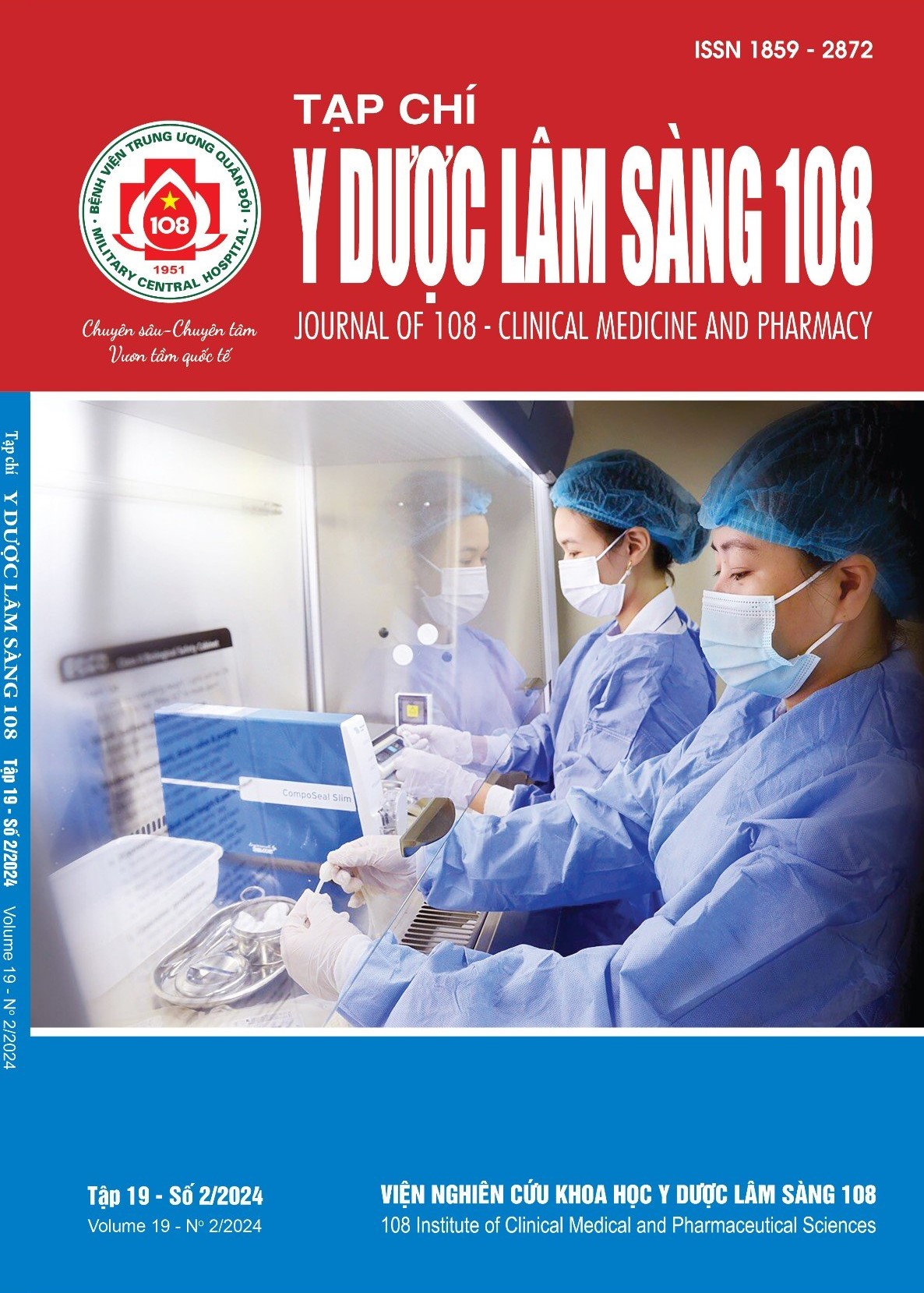Clinical, paraclinical characteristics and microbiological agents in exacerbation of chronic obstructive pulmonary disease with pneumonia
Main Article Content
Keywords
Abstract
The exacerbations of chronic obstructive pulmonary disease (COPD) was the main reason leading patients to hospitalization and worsening of the disease, which can increase mortality, especially when the exacerbation with pneumonia. Objective: To study clinical, paraclinical characteristics and sputum microbiological agents in exacerbation of chronic obstructive pulmonary disease with pneumonia. Subject and method: Cross-sectional study involving 138 patients were diagnosed with exacerbation of COPD, comprising 92 patients were exacerbation of COPD with pneumonia (disease group) and 46 patients were exacerbation of COPD without pneumonia (control group). Result: The disease group was mainly male and elderly with many symptoms and risk factors. The proportion of patients with fever, respiratory failure, average CAT score, mMRC, average white blood cell count, and percentage of neutrophils in the disease group were higher than in the control group with statistical significance (p<0.05). Positive rate of agents in disease group (79.35%) was observed to be higher than in the control group (67.39%), but the difference was not statistically significant (p>0.05). The rate of single-agent or
≥ 2 agents did not show a significant difference between the two groups. Among the bacteria group Klebsiella pneumoniae was found at the highest rate in the disease group (67.12%) as well as the control group (77.41%), Haemophilus influenzae was more prevalent in the disease group (24.65%) compared to the control group (12.90%) (p>0.05). In the group of atypical bacteria, Mycoplasma pneumoniae, and Legionella pneumophila, had similar occurrences in the disease group (4.10%) and the control group (3.22%). The positive rate for influenza A/B virus was 6.84% in the disease group compared to the control group (9.67%) (p>0.05). Conclusion: The proportion of patients with fever, respiratory failure, average CAT score, mMRC, average white blood cell count, and percentage of neutrophils in the disease group were higher than in the control group with statistical significance (p<0.05). The detection rate of microbiological agents in sputum was quite high in both groups. However, there was no obvious difference between the disease group and the control group.
Article Details
References
2. Qureshi H, Sharafkhaneh A, Hanania Nicola A. (2014) Chronic obstructive pulmonary disease exacerbations: latest evidence and clinical implications. Ther Adv Chronic Dis 5(5): 212-227. doi: 10.1177/2040622314532862.
3. Sapey E, Stockley RA (2006) COPD exacerbations . 2: aetiology. Thorax 61(3): 250-258. http://www.ncbi.nlm.nih.gov/pubmed/16517585.
4. Sethi S, Murphy TF (2008) Infection in the pathogenesis and course of chronic obstructive pulmonary disease. N Engl J Med 359(22): 2355-2365.
5. Singh D, Agusti A, Anzueto A, Barnes PJ, Bourbeau J, Celli BR, Criner GJ, Frith P, Halpin DMG, Han M, López Varela MV, Martinez F, Montes de Oca M, Papi A, Pavord ID, Roche N, Sin DD, Stockley R, Vestbo J, Wedzicha JA, Vogelmeier C (2019) Global Strategy for the Diagnosis, Management, and Prevention of Chronic Obstructive Lung Disease: The GOLD science committee report 2019. Eur Respir J 53(5):1900164. doi: 10.1183/13993003.00164-2019.
6. CDC/NHSN (2014) Surveillance Definitions for Specific Types of Infections: 30-36.
7. Lương Ngọc Khuê, Đoàn Mai Phương, Nguyễn Vũ Trung và cộng sự (2018) Hướng dẫn quy trình kỹ thuật chuyên ngành Vi sinh. Nhà xuất bản Y học.
8. Roche N, Kouassi B, Rabbat A et al (2007) Yield of sputum microbiological examination in patients hospitalized for exacerbations of chronic obstructive pulmonary disease with purulent sputum. Respiration 74(1): 19-25.
9. Sin DD, Man SF (2003) Why are patients with chronic obstructive pulmonary disease at increased risk of cardiovascular diseases? The potential role of systemic inflammation in chronic obstructive pulmonary disease. Circulation 107(11): 1514-1419, doi: 10.1161/01.cir.0000056767.69054.b3.
10. Gan WQ, Man SFP, Senthilselvan A et al (2004) Association between chronic obstructive pulmonary disease and systemic inflammation: A systematic review and a meta-analysis. Thorax 59(7): 574-580.
11. Lê Hoàn, Lê Minh Hằng, Đinh Thị Thanh Hồng và cộng sự (2021) Xác định căn nguyên nhiễm trùng đường hô hấp dưới cộng đồng bằng kỹ thuật chuỗi phản ứng polymerase đa mồi tại Bệnh viện Đại học Y Hà Nội. Tạp chí Nghiên cứu Y học, 147(11).
12. Phạm Hùng Vân, Nguyễn Văn Thành, Trần Văn Ngọc và cộng sự (2018) Tác nhân vi sinh gây nhiễm trùng hô hấp dưới cộng đồng cấp tính không nhập viện - Kết quả bước đầu từ nghiên cứu EACRI. Tạp chí Hội hô hấp TP. Hồ Chí Minh, 142(5).
13. Kenichiro S, Yutaka Y, Miyuki M et al (2015) Pathogens in COPD exacerbations identified by comprehensive real-time PCr plus older methods. International Journal of COPD 2015(10): 2009-2016.
14. Tạ Thị Diệu Ngân (2016) Nghiên cứu đặc điểm lâm sàng, cận lâm sàng và căn nguyên của viêm phổi mắc phải tại cộng đồng. Luận văn Tiến sĩ,
Trường Đại học Y Hà Nội.
15. Sonia S, Jean-Laurent I, Sophie B et al (2023)
Real-time PCR has advantages over culture-based methods in identifying major airway bacterial pathogens in chronic obstructive pulmonary disease: Results from three clinical studies in Europe and North America. Frontiers in Microbiology 2: 1-13.
16. Anant M, Subhash C, Dipti A et al (2010) Prevalence of viral infection detected by PCR and RT-PCR in patients with acute exacerbation of COPD:
A systematic review. Respirology 15: 536-542.
17. Diederen BMW, Valk PDLPM, Kluytmans JAWJ et al (2007) The role of atypical respiratory pathogens in exacerbations of chronic obstructive pulmonary disease. European Respiratory Journal 30(2): 240-244.
18. Falsey AR, Becker KL, Swinburne AJ et al (2012), Utility of serum procalcitonin values in patients with acute exacerbations of chronic obstructive pulmonary disease: A cautionary note. International Journal of Chronic Obstructive Pulmonary Disease 7: 127-135.
19. Chang CH, Tsao KC, Hu HC et al (2015) Procalcitonin and C-reactive protein cannot differentiate bacterial or viral infection in COPD exacerbation requiring emergency department visits. International Journal of Chronic Obstructive Pulmonary Disease 10: 767-774.
 ISSN: 1859 - 2872
ISSN: 1859 - 2872
